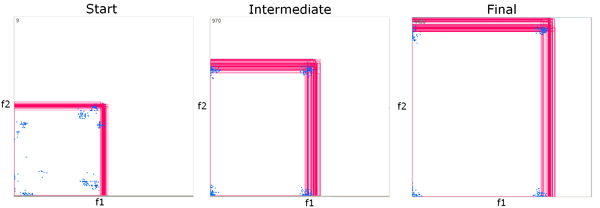Evolution of Clarity - Self organization in vowel systems
This project was done by Steijn Kistemaker and Nadya Peek during the class Evolution of Speech taught by Bart de Boer in spring 2008.
We use an agent-based evolutionary model of the vowel system. This model uses genetic algorithms which selects agents on clarity - or mutual understanding - which is tested with an imitation game. The individual vowel systems thus converge to a global common which allows the agents to best understand each other. The articulatory space that the agents use to produce the vowels also evolves to better accommodate clarity. We have found that during evolution the agents finally reach an optimal articulatory space which allows for maximal clarity without needing to increase in size.

An example of an imitation game. On the left, we see agent 1 communicating the vowel circled in red. Agent 2 on the right interprets the vowel and attempts to imitate it. If the imitation leads to an interpretation with agent 1 which is the same as the vowel agent 1 initially communicated, there is success.
Introduction
Language is both individual and global. Children begin to speak at an early age,
but the utterances they make are only understood by a select group of individuals-
those who speak the same language. If a child would begin to make sounds that
are very distinct and easy to tell apart, then that may be considered as a more clear
language, but no one in the community would understand the child. If the child
was born into a community with a language consisting of sounds which are very
similar, then communication might fail because the sounds are not easy to distinguish. The child cannot change the language of its community by himself, but
perhaps the language will evolve itself to allow for more clarity in the community.
How do sets of phonemes evolve in the first place though? How did communities begin to distinguish sounds, and group them to form words? What is the
starting point for a system of sounds which then makes up a language? In this
paper we will research how a set of sounds can develop within a community of
language speakers, and how the speaker may change the articulatory space they
use to make the sounds.
Hypothesis
Though there have been simulations of the optimal distribution of vowels in the
literature, these simulations all consider a fixed size for
the articulatory space of the agents. Whether the articulatory space should coevolve with the localization and focalization of the vowels has not been extensively
simulated yet. In this paper we will therefore present a model for the simulation
of the localization of vowels in variable articulatory spaces by a community of
agents. Using this model and an evolution schema of genetic algorithms, we will
experimentally determine whether the articulatory space of agents will coevolve
with the localization of the vowels. We expect the articulatory space to grow as
the agents evolve to more salient distributions of vowels, which require distance
within the articulatory space.
Model
Our model consists of two main parts; the communication cycle and the evolution-
ary cycle. In the communication cycle the agents aim to understand each other.
If the communication is successful, the fitness of the communicating agents in-
creases. Fit agents then pass successful traits on to their offspring in the evolution
cycle.
Experiments
We used agents with vowel systems with between 2 and 10 vowels, and evolved the societies to evaluate the final positioning of the vowels.

Above on the x-axis we have the first formant, and on the y-axis the second formant. The vowels are shown as blue dots
Above we can see the migration of the vowels within a fixed articulatory space for 2, 3, 4 and 5 vowels. The positioning is not mathematically optimal, but it is perceptually sufficiently distinct.

Here the articulatory space that the agent is able to produce vowels in is determined by the pink lines. The vowel systems therefore must exist within this space.
The articulatory space grows for more clarity as evolution proceeds, but it does not do so indefinitely. Once sufficient perceptual contrast is reached, the articulatory space remains at a particular size. This size is defined by the amount of noise that is possible when communicating a vowel.
More information on this project can be found in the project paper.
